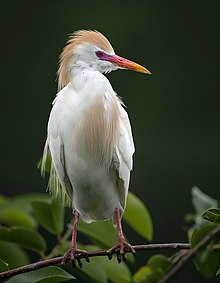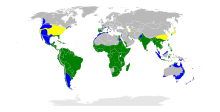
Back بوبولكس ARZ Vağcıq Azerbaijani Bubulcus Breton Bubulcus (gènere) Catalan Bubulcus CEB گاوچرانکها Persian Bubulcus French אנפית בקר HE Bubulcus Hungarian Bubulcus Italian
| Cattle egret | |
|---|---|

| |
| Breeding-plumaged adult in Wakodahatchee Wetlands | |
| Scientific classification | |
| Domain: | Eukaryota |
| Kingdom: | Animalia |
| Phylum: | Chordata |
| Class: | Aves |
| Order: | Pelecaniformes |
| Family: | Ardeidae |
| Subfamily: | Ardeinae |
| Genus: | Bubulcus Bonaparte, 1855 |
| Species | |
|
B. ibis (Linnaeus, 1758) | |

| |
| Range of Bubulcus breeding non-breeding year-round
| |
The cattle egret (Bubulcus) is a cosmopolitan genus of heron (family Ardeidae) found in the tropics, subtropics, and warm-temperate zones. According to the IOC bird list, it contains two species, the western cattle egret and the eastern cattle egret, although some authorities regard them as a single species. Despite the similarities in plumage to the egrets of the genus Egretta, it is more closely related to the herons of Ardea. Originally native to parts of Asia, Africa, and Europe, it has undergone a rapid expansion in its distribution and successfully colonised much of the rest of the world in the last century.
They are white birds adorned with buff plumes in the breeding season. They nest in colonies, usually near bodies of water and often with other wading birds. The nest is a platform of sticks in trees or shrubs. Cattle egrets exploit drier and open habitats more than other heron species. Their feeding habitats include seasonally inundated grasslands, pastures, farmlands, wetlands, and rice paddies. They often accompany cattle or other large mammals, catching insect and small vertebrate prey disturbed by these animals. Some populations are migratory and others show postbreeding dispersal.
The adult cattle egret has few predators, but birds or mammals may raid its nests, and chicks may be lost to starvation, calcium deficiency, or disturbance from other large birds. This genus maintains a special relationship with cattle, which extends to other large grazing mammals; wider human farming is believed to be a major cause of their suddenly expanded range. The cattle egret removes ticks and flies from cattle and consumes them. This benefits both organisms, but it has been implicated in the spread of tick-borne animal diseases.
- ^ BirdLife International (2019). "Bubulcus ibis". IUCN Red List of Threatened Species. 2019: e.T22697109A155477521. doi:10.2305/IUCN.UK.2019-3.RLTS.T22697109A155477521.en.
